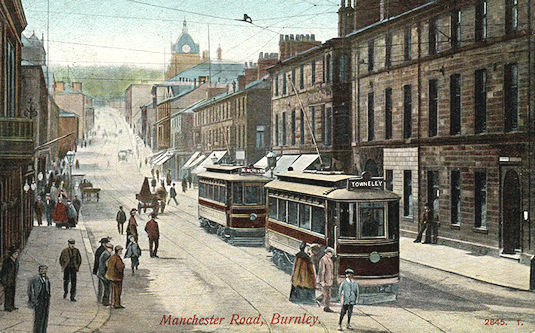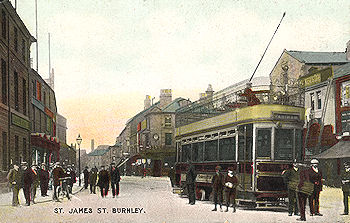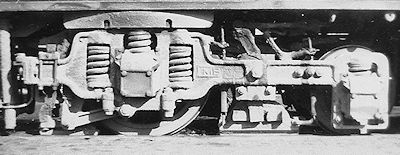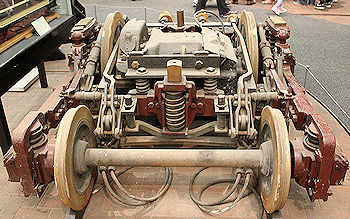

Our postcard is No. 2845 in the Hartmann series, published around 1905 with our copy being posted in 1910. It shows two single-deck trams in Manchester Road, Burnley. The leading car is bound for Towneley. The smaller view below of about the same date is in the Branch series by a local Burnley company, whose initials were A. H.& S. It is in St. James Street, Burnley with a double-deck car 10 heading for Padiham.
The first tramways in Burnley were seven miles of standard gauge steam routes of the Burnley & District company, which opened in 1879. In 1900 that company sold out to Burnley and other local authorities. The corporation rebuilt the tracks to 4ft gauge and an electric tram service started on 16th December 1901. After extension, the tramway reached an extent of thirteen miles and there was through running over the tracks of the tramways of neighbouring Nelson (see postcard). The routes ran from the centre of Burnley to Padiham in the west, Nelson in the north, Brunshaw in the east and Towneley and Summit to the south. There were 19 single-deck trams and 53 double-deckers, all in a chocolate and primrose livery, and stabled at Queens Gate depot, just off Colne Road.
 The single-deck trams in our postcard were from a batch of eight cars (39-46) built in 1903 by the Electric Tramway and Carriage Works of Preston. They had Brill 27G equal-wheel bogies and Dick, Kerr electrical equipment. They seated 44. Double-decker 10 (right) was one of twenty-four built 1901-2 by Geo. F. Milnes. They had Brill 22E maximum traction bogies, General Electric motors and BTH controllers. They seated 32 on the lower-deck and 39 on the upper. In 1914 the 27G bogies were replaced by 'Burnley' maximum traction bogies and around the same date the 22E bogies were converted to the 'Burnley' system.
The single-deck trams in our postcard were from a batch of eight cars (39-46) built in 1903 by the Electric Tramway and Carriage Works of Preston. They had Brill 27G equal-wheel bogies and Dick, Kerr electrical equipment. They seated 44. Double-decker 10 (right) was one of twenty-four built 1901-2 by Geo. F. Milnes. They had Brill 22E maximum traction bogies, General Electric motors and BTH controllers. They seated 32 on the lower-deck and 39 on the upper. In 1914 the 27G bogies were replaced by 'Burnley' maximum traction bogies and around the same date the 22E bogies were converted to the 'Burnley' system.
 The 'Burnley' bogie (left) was developed in 1908 by the Burnley General Manager, Henry Mozley, in conjunction with Mountain and Gibson (M&G). A radial truck from Simpson & Park (similar to one tried experimentally by the LCC on a D class car in 1905-6), was used on Burnley single-deck car 47 of 1907, but was not successful. M&G modified the radial sub-frames by adding pony-wheels. The weight of the tram, carried on side bearing pads, and the pivotal point were directly over the driving axle, with a proportion of weight being transferred to the pony axle by a sprung plunger. This way about 80% of the weight was on the driving wheels, as to opposed to about 70% on conventional maximum traction bogies.
The 'Burnley' bogie (left) was developed in 1908 by the Burnley General Manager, Henry Mozley, in conjunction with Mountain and Gibson (M&G). A radial truck from Simpson & Park (similar to one tried experimentally by the LCC on a D class car in 1905-6), was used on Burnley single-deck car 47 of 1907, but was not successful. M&G modified the radial sub-frames by adding pony-wheels. The weight of the tram, carried on side bearing pads, and the pivotal point were directly over the driving axle, with a proportion of weight being transferred to the pony axle by a sprung plunger. This way about 80% of the weight was on the driving wheels, as to opposed to about 70% on conventional maximum traction bogies.
 The design was used on many narrow-gauge systems in the Midlands, most notably Birmingham Corporation. Bogies on this principle were manufactured by UEC, English Electric, M&G, EMB, Maley & Taunton and Brush. An example of a Birmingham 'Burnley' bogie is in the National Tramway Museum (right - photo D.Yates).
The design was used on many narrow-gauge systems in the Midlands, most notably Birmingham Corporation. Bogies on this principle were manufactured by UEC, English Electric, M&G, EMB, Maley & Taunton and Brush. An example of a Birmingham 'Burnley' bogie is in the National Tramway Museum (right - photo D.Yates).
Burnley, Nelson and Colne tramways (and bus services) were operated and managed by a Joint Transport Committee from 1933, but not for long. The Burnley tramway was the last to close, being replaced by motor buses on 7th May 1935.
![]() Go to Postcard Of The Month Index
Go to Postcard Of The Month Index